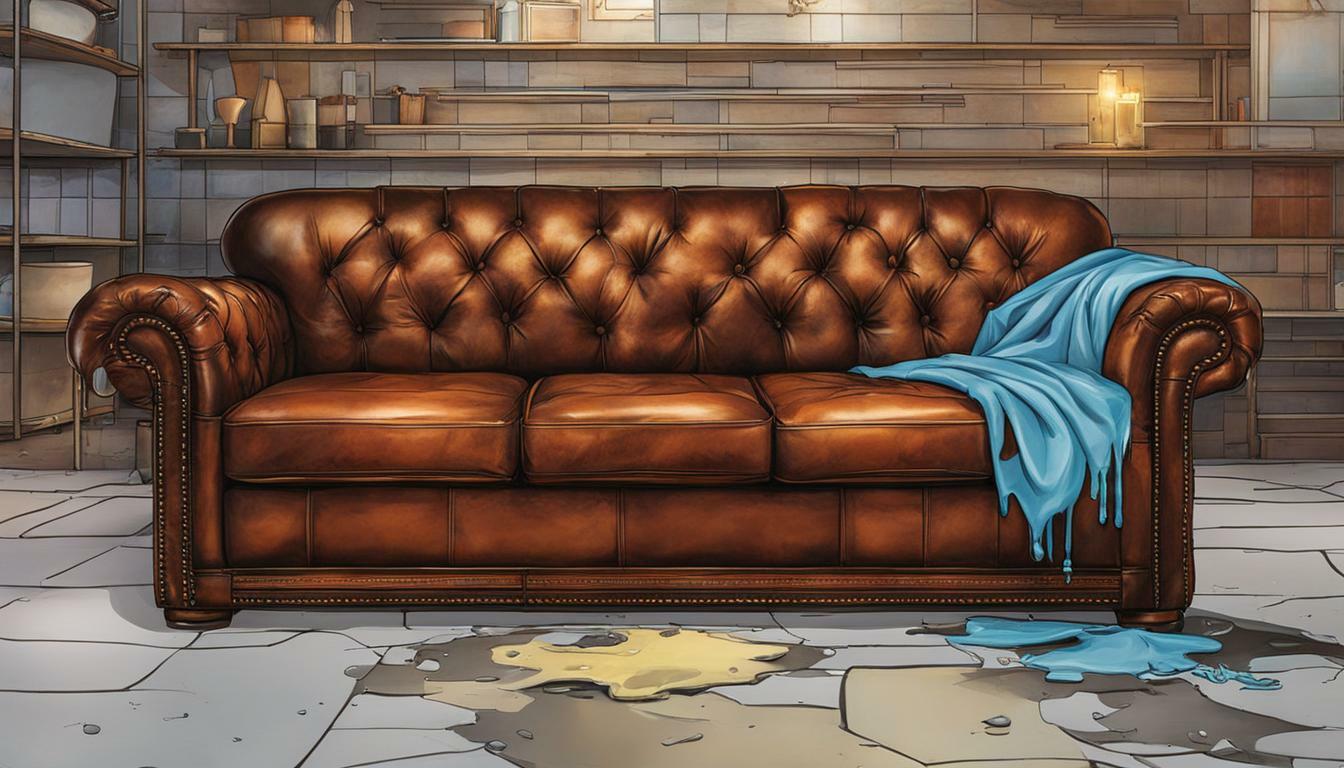
Dyeing a leather couch is a great way to give it a new look and revitalize its appearance. Whether you want to change the color entirely or touch up any worn-out areas, dyeing can be a cost-effective and DIY-friendly solution. In this guide, we will walk you through the process of dyeing a leather couch step by step.
Key Takeaways:
- Prepare the leather surface properly before dyeing.
- Deep clean the leather surface to remove remaining dirt or contaminants.
- Moisten the leather surface for better dye absorption.
- Apply the leather dye in thin layers, working it into gaps, creases, and hard-to-reach areas.
- Remove excess dye and reapply for desired color and coverage.
- Apply the leather finisher for protection and desired appearance.
Materials Required for Dyeing a Leather Couch
To successfully dye a leather couch, you will need the following materials:
| Materials | Description |
|---|---|
| Leather Colourant Kit | This kit contains everything you need to dye your leather couch, including the dye itself, a sponge, and a finisher. |
| Leather Cleaner | This is used to remove any waxes, oils, or silicones that may be present on the leather. |
| Alcohol Cleaner | This is used to deep clean the leather and remove any remaining dirt or contaminants. |
| Sponge | This is used to apply the dye to the leather surface. |
| Spray bottle | This is used to moisten the leather before dyeing. |
| Cloth or rag | This is used to remove excess dye and clean any spills or drips. |
| Leather dye of the desired color | You will need a high-quality leather dye that matches your desired color. |
| Leather finisher (such as Resolene) | This is used to protect the dye and give a glossy or matte appearance, depending on your preference. |
| Hairdryer | This is used to speed up the drying process if needed. |
| Protective gloves | These are used to protect your skin from direct contact with the dye. |
Step 1: Preparation
Before applying any dye, it’s essential to prepare the leather surface properly. Start by removing any waxes, oils, or silicones that may be present on the leather. This can be done by using a leather cleaner to ensure proper adhesion of the dye. If the leather is heavily soiled, clean it first with a mild soap and water mixture. Focus on the back and sides of the couch, as these areas are typically less stressed and do not require thorough cleaning.
Step 2: Deep Cleaning
To remove any remaining dirt or contaminants, use a cloth or rag dampened with acetone or alcohol cleaner to deep clean the leather. These solvents help strip off the manufactured finish and prepare the surface for dyeing. Ensure that the cleaning process is done in a well-ventilated area and allow sufficient time for the cleaners to evaporate before proceeding to the next step.
Step 3: Moistening the Leather
Moistening the leather is crucial for better dye absorption. Fill a spray bottle with water and lightly mist the entire surface of the couch. Be careful not to oversaturate the leather, as excessive moisture can affect the dyeing process. Moist leather allows the dye to penetrate evenly, resulting in a more uniform color.
Step 4: Applying the Leather Dye
Before starting the dyeing process, shake the bottle of leather dye thoroughly to mix it well. Pour a small amount onto a sponge and apply it to the leather surface in thin layers. Work the dye into the gaps, creases, and hard-to-reach areas using long and broad strokes. Apply light pressure to avoid excessive color foam or uneven application.
It’s crucial to note that when dyeing leather, you can change from a darker color to a lighter color, but not vice versa. Choose a high-quality leather dye that matches your desired color, as low-quality products may yield unsatisfactory results and potentially harm the leather. Wear protective gloves to prevent any direct contact with the dye.
Step 5: Removing Excess Dye and Re-Application
After applying the dye, use a dry cloth to remove any excess dye from the surface of the leather. This helps achieve a more even and natural look. Allow the first coat of dye to dry naturally or speed up the process with a hairdryer on a low setting. Once dry, assess the color and coverage and determine if additional coats are needed. Apply additional coats of dye using the same technique, ensuring even coverage and allowing each coat to dry before reapplication.
Step 6: Applying the Leather Finisher
Once you are satisfied with the color and coverage, it’s time to apply the leather finisher. This protects the dye and gives a glossy or matte appearance, depending on your preference. Mix the leather finisher according to the instructions provided by the manufacturer, and apply it using a clean cloth or sponge. Ensure thorough coverage, and allow it to dry completely before using the couch.
It’s important to note that there are different types of leather finishes available, such as gloss, semi-gloss, satin, semi-matt, and matte. Choose the finish that suits your desired look and follow the manufacturer’s guidelines for mixing and application.
Applying a leather finisher is an essential step in the dyeing process as it helps protect the dye from fading or wearing off over time. It also gives your leather couch a beautiful finish and can rejuvenate the appearance of the leather. A glossy finish gives a shiny and polished look, whereas a matte finish looks more natural and understated.
The type of finish you choose depends on your preferences and the style of your home. Additionally, the finisher will protect the leather from further wear and tear, ensuring that your newly dyed couch remains in good condition for years to come.
Conclusion
Dyeing a leather couch is a cost-effective DIY solution that can transform the appearance of your furniture. By following the step-by-step guide provided in this article, you can successfully dye your leather couch, refresh its color, and revitalize its overall look.
Transforming the color of your leather couch requires careful execution, attention to detail, and the use of appropriate materials. It’s essential to prepare the leather surface thoroughly, deep clean it, moisten it, apply the dye in thin layers, remove any excess dye, and apply the leather finisher.
Remember to wear protective gloves throughout the process and choose high-quality products that match your desired color. Test the dye and finisher on a small, inconspicuous area of the couch before proceeding with the entire process to ensure compatibility and satisfactory results.
Finally, enjoy your refreshed furniture and the new look it brings to your home. With a little patience and effort, you can give your leather couch a new lease on life and enjoy it for years to come. So what are you waiting for? Give your couch a boost of color and start dyeing today!
FAQ
Q: Can I dye a leather couch to change its color entirely?
A: Yes, dyeing a leather couch can change its color entirely and give it a new look.
Q: What materials do I need to dye a leather couch?
A: You will need a Leather Colourant Kit, leather cleaner, alcohol cleaner, sponge, spray bottle, cloth or rag, leather dye, leather finisher, hairdryer, and protective gloves.
Q: How do I prepare the leather surface before dyeing?
A: Start by removing any waxes, oils, or silicones with a leather cleaner. If the leather is heavily soiled, clean it with a mild soap and water mixture.
Q: How do I deep clean the leather?
A: Use a cloth or rag dampened with acetone or alcohol cleaner to deep clean the leather and remove any remaining dirt or contaminants.
Q: Why is it important to moisten the leather before dyeing?
A: Moistening the leather helps with better dye absorption. Use a spray bottle to lightly mist the surface, ensuring not to oversaturate it.
Q: How do I apply the leather dye?
A: Shake the dye bottle, pour a small amount onto a sponge, and apply it in thin layers to the leather surface. Work the dye into gaps, creases, and hard-to-reach areas using long, broad strokes.
Q: Is it necessary to remove excess dye?
A: Yes, after applying the dye, use a dry cloth to remove any excess dye from the surface for a more even and natural look.
Q: Can I apply multiple coats of dye?
A: Yes, if needed, you can apply multiple coats of dye to achieve the desired color and coverage. Allow each coat to dry before reapplication.
Q: Why should I apply a leather finisher?
A: Applying a leather finisher protects the dye and gives a glossy or matte appearance. There are different types of finishes available, such as gloss, semi-gloss, satin, semi-matt, and matte.
Q: Can I transform the color of my leather couch with dyeing?
A: Yes, dyeing can transform the color of your leather couch and give it a refreshed and vibrant look.




